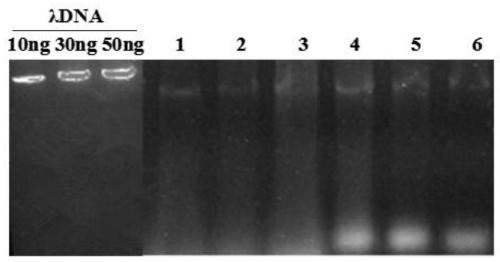Qualitative and/or quantitative extraction method of microbial DNA on the surface of large particle matrix of constructed wetland
A technology of constructed wetlands and extraction methods, which is used in the determination/inspection of microorganisms, biochemical equipment and methods, and treatment of granular microorganism carriers, etc. question
- Summary
- Abstract
- Description
- Claims
- Application Information
AI Technical Summary
Problems solved by technology
Method used
Image
Examples
Embodiment 1
[0062] Example 1: Extraction of microbial DNA from gravel surfaces in constructed wetlands
[0063] Constructed wetland gravel sample collection:
[0064] In this embodiment, gravel samples are collected from a group of horizontal subsurface flow constructed wetlands for treating domestic sewage. The wetland device is 80 cm long, 60 cm wide, and 80 cm high. The wetland matrix is gravel (particle size 1-2cm), and the filling height is 60cm. The no-plant group, the canna group and the Zailihua group are respectively set. The hydraulic load of the device is 2.5m / d, and it operates continuously throughout the day. The matrix samples are collected near the water inlet and near the water outlet respectively. The matrix at the surface 0-10cm is mixed as the surface sample, and the matrix at the bottom 30-40cm is mixed as the bottom sample. There are 6 samples in three devices, 3 of which are surface samples and 3 are bottom samples. About 200g of matrix is collected and put into...
Embodiment 2
[0085] Example 2: Extraction of microbial DNA from gravel surfaces in constructed wetlands
[0086] Constructed wetland gravel sample collection:
[0087] In this example, gravel samples are collected from a group of horizontal subsurface flow artificial wetlands for domestic sewage treatment. The wetland device is 80 cm long, 60 cm wide, and 80 cm high. The wetland matrix is gravel (particle size 1-2 cm), and the filling height is 60 cm. group, Canna group and Zailihua group. The hydraulic load of the device is 2.5m / d, and it operates continuously throughout the day. The matrix samples are collected near the water inlet and near the water outlet respectively. The matrix at the surface 0-10cm is mixed as the surface sample, and the matrix at the bottom 30-40cm is mixed as the bottom sample. There are 6 samples in three devices, 3 of which are surface samples and 3 are bottom samples. About 200g of matrix is collected and put into sterile sealed bags for later use. Each sa...
Embodiment 3
[0108] Embodiment 3 comparative test
[0109]In order to compare the present invention (embodiment 1 and embodiment 2, claim the present invention in the following data and samples) and the extraction effect of existing non-corruption treatment method and kit method, the applicant has carried out utilizing non-corrosion treatment simultaneously Method and kit method experiments, specific operations are as follows:
[0110] (1) This method does not carry out calcium chloride and sodium oxalate treatment, and other steps are identical with embodiment 1 or embodiment 2, and the formula of DNA extraction liquid is (100mM Tris-HCl, 100mM EDTA, 200mM NaCl, 2%PVPP, 3% CTAB, pH 8.0).
[0111] (2) use DNA Isolation Kit (MO BIO Laboratories Inc., Carlsbad, CA, USA) was used to extract genomic DNA, and all the liquid and grinding beads in the PowerBead Tubes were transferred to a 2mL centrifuge tube containing 0.5g of precipitate, and the rest of the steps were carried out according t...
PUM
| Property | Measurement | Unit |
|---|---|---|
| particle diameter | aaaaa | aaaaa |
Abstract
Description
Claims
Application Information
 Login to View More
Login to View More - R&D
- Intellectual Property
- Life Sciences
- Materials
- Tech Scout
- Unparalleled Data Quality
- Higher Quality Content
- 60% Fewer Hallucinations
Browse by: Latest US Patents, China's latest patents, Technical Efficacy Thesaurus, Application Domain, Technology Topic, Popular Technical Reports.
© 2025 PatSnap. All rights reserved.Legal|Privacy policy|Modern Slavery Act Transparency Statement|Sitemap|About US| Contact US: help@patsnap.com



